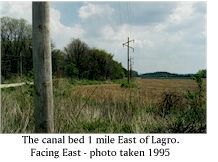  Lagro took its
name from the Miami Indian Chief Le Gros. In 1828, a two room brick house was constructed
for him at this site. He occupied the home until his death in 1831. Lagro took its
name from the Miami Indian Chief Le Gros. In 1828, a two room brick house was constructed
for him at this site. He occupied the home until his death in 1831.
Miami Erie & Wabash Canal Country. Harry G. Black.
1991. page 49.

 On the site of
this old Indian town, Gen. Tipton had laid out a town which he called La Gro. But at what
time this town was laid out I have never been able to ascertain. The original plat,
however was recorded in Book A, page 55, of the records of Huntington county, but at what
date the record fails to state, though the instrument recorded this bears the date May 18,
1835, and the one on the page On the site of
this old Indian town, Gen. Tipton had laid out a town which he called La Gro. But at what
time this town was laid out I have never been able to ascertain. The original plat,
however was recorded in Book A, page 55, of the records of Huntington county, but at what
date the record fails to state, though the instrument recorded this bears the date May 18,
1835, and the one on the page 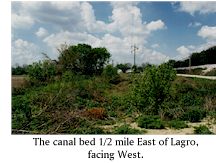 following, June 10, 1835, so
that we can approach the date of recording the Plat. The first lots sold in the town,
numbered 174, 175 and 176, to Jacob Chappel, the deed for which was acknowledged September
18, 1834, so that we can conclude the town was laid out at least as early as September,
1834. following, June 10, 1835, so
that we can approach the date of recording the Plat. The first lots sold in the town,
numbered 174, 175 and 176, to Jacob Chappel, the deed for which was acknowledged September
18, 1834, so that we can conclude the town was laid out at least as early as September,
1834.

At the time of our visit, aside from a few Indian houses and canal
shanties, the place contained not more than half a dozen houses.
History of Wabash County. 1884 p.106

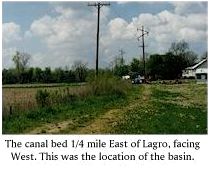  Less than 200
feet east of the Jim Curr sic lock is Lagro Creek,
Over this creek in the days of the canal was the canal bed. This was accomplished by a low
wide archway permitting the creek to flow under the bed. The archway was wide enough to
take care of surplus water during the rainy seasons. Its actual width, height, and length
cannot be determined. It is possible to imagine its approximate location and if one was a
more persistent digger than what I am they or he might be able to locate the foundation
for the archway. Less than 200
feet east of the Jim Curr sic lock is Lagro Creek,
Over this creek in the days of the canal was the canal bed. This was accomplished by a low
wide archway permitting the creek to flow under the bed. The archway was wide enough to
take care of surplus water during the rainy seasons. Its actual width, height, and length
cannot be determined. It is possible to imagine its approximate location and if one was a
more persistent digger than what I am they or he might be able to locate the foundation
for the archway.

The canal bed was made of limestone at this place as was the archway and
the sides of the canal, with soil filled on the outside of the bed allowing a towpath.
Notes made by C.A. Anderson & E.L. Martin during
W.P.A. Project. June, 1936

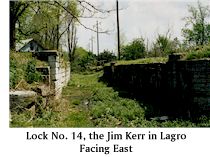  Locks Nos. 14 (Jim Kerr) and 15 (Jim Ditton) , situated in the town of Lagro,
each six feet lift, built out of stone. The stone procured from Salamania quarry. In
certain portions of the wall, the stone are beginning to decay. The locks being of small
lift, will doubtless answer the purpose for many years. The gates of both need renewal in
1850. Locks Nos. 14 (Jim Kerr) and 15 (Jim Ditton) , situated in the town of Lagro,
each six feet lift, built out of stone. The stone procured from Salamania quarry. In
certain portions of the wall, the stone are beginning to decay. The locks being of small
lift, will doubtless answer the purpose for many years. The gates of both need renewal in
1850.
Chief Engineers report to the Commissioners. Jesse L.
Williams. November 1, 1847

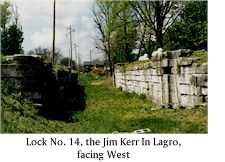  The "Jim Curr sic
lock. South of Washington Street at the extreme south end of Canal Street and on the north
side of the Interurban track, back of Mrs. Bechtol's residence, is the Kim Kerr lock. This
lock measures: 110 feet long; wings measure 12' 10" in length; here, as in the lock
east of town you may see niches in the wall of the canal allowing the gates to swing back
flat with the sides of the canal thus removing the possibility of a canal boat damaging
the gate or boat. From the wing back 15' 9" we find the niche which measures 12'
5". Then we find a straight-of-way extending for 56' 6" following which is
another niche, then a short straight-of-way of 15' 9" and another wing. Jim Kerr
maintained a supply store at this lock in the old days. The "Jim Curr sic
lock. South of Washington Street at the extreme south end of Canal Street and on the north
side of the Interurban track, back of Mrs. Bechtol's residence, is the Kim Kerr lock. This
lock measures: 110 feet long; wings measure 12' 10" in length; here, as in the lock
east of town you may see niches in the wall of the canal allowing the gates to swing back
flat with the sides of the canal thus removing the possibility of a canal boat damaging
the gate or boat. From the wing back 15' 9" we find the niche which measures 12'
5". Then we find a straight-of-way extending for 56' 6" following which is
another niche, then a short straight-of-way of 15' 9" and another wing. Jim Kerr
maintained a supply store at this lock in the old days.
Notes made by C.A. Anderson & E.L. Martin during
W.P.A. Project. June, 1936
 On
Monday night about 10 o'clock, a body of men of the town of Lagro, six miles east of this
city, took the dead body of James Kerr from the lock at that place. Kerr had been in town
during the greater part of the day, and while there he became intoxicated. He started for
home at 10 o'clock, and when crossing the lock on a plank, he fell below, striking his
head on a log, killing him instantly. Mr. Kerr was seventy years old, and had been a
resident for several years. On
Monday night about 10 o'clock, a body of men of the town of Lagro, six miles east of this
city, took the dead body of James Kerr from the lock at that place. Kerr had been in town
during the greater part of the day, and while there he became intoxicated. He started for
home at 10 o'clock, and when crossing the lock on a plank, he fell below, striking his
head on a log, killing him instantly. Mr. Kerr was seventy years old, and had been a
resident for several years.
The Wabash (Weekly) Times - Friday Oct. 16, 1885
 At
eight o'clock Tuesday morning, the Plain Dealer was notified by telephone that James Kerr,
one of the oldest inhabitants of LaGro had been found dead in the canal lock, and a
representative of this paper was sent there by the first train. He learned that the old
gentleman was found sitting in the bottom of the lock about 7 o'clock by a son of
Sylvester Joy, who at once gave the alarm. At
eight o'clock Tuesday morning, the Plain Dealer was notified by telephone that James Kerr,
one of the oldest inhabitants of LaGro had been found dead in the canal lock, and a
representative of this paper was sent there by the first train. He learned that the old
gentleman was found sitting in the bottom of the lock about 7 o'clock by a son of
Sylvester Joy, who at once gave the alarm.
As soon as help came the body, which was only partially submerged --there being but little
water in the lock -- was taken out and carried to his house, only a few feet away. The
last time Kerr was seen alive was on the previous evening when he was taken home, while
under the influence of liquor, by Con. [Constable?] O'Brian. Kerr's house stands on the
south bank of the canal, and it is approached by a narrow footbridge over the lock; and it
is supposed that either sometime during the night, or else early in the morning, the old
man attempted to cross the bridge, and in the darkness lost his footing and fell. Death
must have ensued immediately, for there is nothing to show that he ever moved a muscle
after falling. Coroner Zimmerman made an investigation, and found the cause of death in
accordance with the facts given above.
The funeral was held on Wednesday. James Kerr was a native of Scotland, but he had lived
in La Gro nearly ever since the place was settled. He was a well-informed, intelligent
man, and in former years was possessed of considerable wealth; he was engaged in keeping a
canal-boat supply house while the canal was in operation, and owned a fine house. In later
years he indulged his appetite for liquor until his fortune was gone, and the house a
miserable wreck. He lived in one room, in which were stored all his provisions for the
winter, while in the cellar beneath was a large flock of chickens. He was a genial old man
and in spite of his eccentricities was liked by everybody. He leaves two sons, one living
in this city and one in Kansas.
This footbridge is a horrible man-trap, no less than four persons having met their death
at the place. It does seem as if some means ought to be employed to improve the condition
of things. Wabash Plain Dealer - Friday Evening,
Oct. 16, 1885
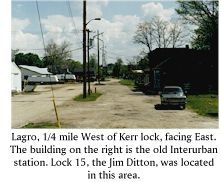  The "Jim
Ditton" Canal lock. This lock is located between Davis and Dover Streets, north of
the Interurban station, It was so named because of the man who operated a supply depot
there. This store, as well as others located at the strategic locks of Lagro, and east,
sold everything from hay and whiskey to trinkets and nick-nacks. This particular lock
today is in very poor state due to the destructive element commonly called man. The "Jim
Ditton" Canal lock. This lock is located between Davis and Dover Streets, north of
the Interurban station, It was so named because of the man who operated a supply depot
there. This store, as well as others located at the strategic locks of Lagro, and east,
sold everything from hay and whiskey to trinkets and nick-nacks. This particular lock
today is in very poor state due to the destructive element commonly called man.
Notes made by C.A. Anderson & E.L. Martin during
W.P.A. Project. June, 1936

 Just below lock
No. 15, the feeder is introduced from the Wabash River, by a set of wooden culverts and
head gates, placed under the towing path, the culverts being under water. The head gates
are in good order. Just below lock
No. 15, the feeder is introduced from the Wabash River, by a set of wooden culverts and
head gates, placed under the towing path, the culverts being under water. The head gates
are in good order.

Wabash dam No. 2, erected for the purpose of this feeder, is situated
immediately at the town of Lagro. It is 280 feet long, and 7 feet high, resting on a rock
bottom, and formed of cribs filled with stone. The abutments are of stone, and the whole
structure is permanent and in good condition, with the exception of a wing to the south
abutment, which is wood, and will need rebuilding in 1849.

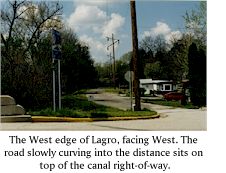  On a
bluff at Davis and US. 24 stands a two story brick home said to be an old canal inn. It
was considered by some to be the best hotel on the canal. On a
bluff at Davis and US. 24 stands a two story brick home said to be an old canal inn. It
was considered by some to be the best hotel on the canal.
The Miami, Wabash, and Erie Canal Country. Harry G.
Black 1991. Page 50

 Tired and worn,
he was directed to the Kellar House or Hotel for meals, a place to sleep and where his
mount could receive care. Tired and worn,
he was directed to the Kellar House or Hotel for meals, a place to sleep and where his
mount could receive care.

In the fifties, the freight houses here in Lagro were doing a thriving
business. Parts of these buildings are still standing (1933) and were made from the
choicest timbers to be gleaned from the land. The stones supporting these same ware houses
were quarried a short distance from the Salamonie River which empties into the Wabash and
were brought to Lagro on flat boats. The uniform work of the stone masons , still
standing, indicates the skill of the builders of that early day. The stone used in
building the canal locks was also brought down the river.
Pioneer Days in the Wabash Valley. Flossie Enyart
Bailet. 1933
 For a
time after his return [from Ireland] James Elward maintained a residence in Pennsylvania,
and while there made the acquaintance of Robert English, a contractor, who was later
engaged in the construction of the old Wabash and Erie Canal in Indiana. In the year 1833
Mr. Elward, with others, drove ox team wagons loaded with tools and equipment to be used
on canal construction work to Lagro, at that time the largest and most promising town in
the county of Wabash. For a considerable time thereafter he was engaged in the work of
hauling stone for the building of the canal locks, makng his home in Lagro. The work on
the canal was of necessity suspended durng the winter months, so that Mr. Elward decided
he could not better occupy his time than in the improving of a farm. This was followed by
the purchase of an eighty of heavily timbered land some two miles north of Lagro, for
which he paid a hundred dollars, and in the winter seasons he applied himself to the task
of clearing the land... For a
time after his return [from Ireland] James Elward maintained a residence in Pennsylvania,
and while there made the acquaintance of Robert English, a contractor, who was later
engaged in the construction of the old Wabash and Erie Canal in Indiana. In the year 1833
Mr. Elward, with others, drove ox team wagons loaded with tools and equipment to be used
on canal construction work to Lagro, at that time the largest and most promising town in
the county of Wabash. For a considerable time thereafter he was engaged in the work of
hauling stone for the building of the canal locks, makng his home in Lagro. The work on
the canal was of necessity suspended durng the winter months, so that Mr. Elward decided
he could not better occupy his time than in the improving of a farm. This was followed by
the purchase of an eighty of heavily timbered land some two miles north of Lagro, for
which he paid a hundred dollars, and in the winter seasons he applied himself to the task
of clearing the land...
Wabash County, Indiana A
Narrative Account of Its Histrical Progress, Its People, and Its Principal Interests;
Clarkson W. Weesner 1914

 Lagro set a
record for shipments of whiskey, over five thousand barrels at the peak. Lagro set a
record for shipments of whiskey, over five thousand barrels at the peak.
During the month of August the wheat and oats were marketed here and
shipped out by canal boat. Wagons were in line at the ware houses waiting for their turn
to unload. They then bought provisions to take home, including flour, salt, meat, fish and
molasses. Sugar was then a luxury, the real dark is all that could be purchased. For this
reason sorghum was generally used for sweetening.

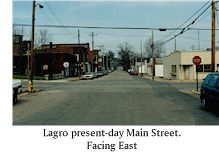 In 1870 the last boats were run on the famous canal.....Lagro became
less progressing with the passing of the canal and passed into a decline, as a great deal
of business was removed to other places, and the village is not so prosperous, since many
employees of the canal and its interests, sought other localities, but each new mode of
travel brought an added thrill to the life of the community. In 1870 the last boats were run on the famous canal.....Lagro became
less progressing with the passing of the canal and passed into a decline, as a great deal
of business was removed to other places, and the village is not so prosperous, since many
employees of the canal and its interests, sought other localities, but each new mode of
travel brought an added thrill to the life of the community.
Indiana Canals. Paul Fatout. Purdue University Press
1972

 1854: Canal boats started hauling in iron
rails for the Lake Erie, Wabash and St. Louis Railroad. 1854: Canal boats started hauling in iron
rails for the Lake Erie, Wabash and St. Louis Railroad.
Bye Gone Memories of Wabash County. 1976. Wabash Bi
Centennial
|